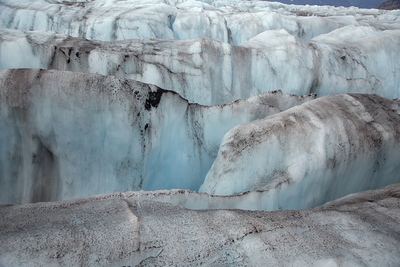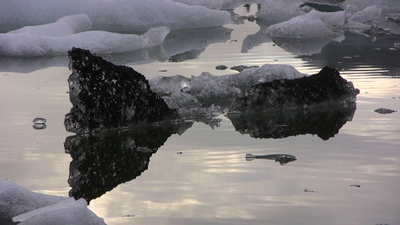The Melting Ice…
by Robert Moeller
Seeing Glacial Time: Climate Change in the Arctic
Through May 18, 2014
Tisch Family Gallery
Tufts University Art Gallery
Aidekman Arts Center
artgallery.tufts.edu
A new United Nations report, one of the most ambitious and wide-ranging assessments of climate change to date, concludes that our day of reckoning is factual, immediate and very much upon us. No longer can we look out over an uncertain future, out over the heads of corrupt (and ignorant) politicians who take their talking points and policies (and campaign funds) from the Koch brothers and energy lobbyists and pretend that all is well. No, coal isn’t king and “Drill, baby drill…” is just an empty, shrill slogan, filled, appropriately, with hot air.
To be clear, our planet isn’t dying. It is changing, and changing fast. And we will either adapt to that fact or life, as we know it, will be swept away. This vast eco-system we inhabit has no preferences, no favorites, or preferred outcomes. Our existence isn’t preordained or sanctioned by some holy writ. It is, rather, closely related to the place we live. And that place is changing fast. Melting permafrost and icecaps, dying coral reefs, the acidification of our oceans, rising temperatures, heat-waves, droughts, and so called mega-disasters featuring water shortages and threats to our food stocks only begin to tell part of the story.
At the Tufts University Art Gallery is the exhibition entitled, Seeing Glacial Time: Climate Change in the Artic, curated by Dr. Amy Ingrid Schlegel, director of galleries and collections. Eight artists using (mainly) photography, painting and video attempt to document the significant changes occurring in the Artic region. Mostly this has to do with ice or more pointedly, melting ice. Camille Seaman has taken a series of photographs from the decks of icebreakers in which she “analogizes icebergs as a species undergoing extinction.” Seaman captures the solitary beauty of the icebergs as they float, sculpted by wind and water, as an almost inanimate species that is somehow alive—rather than a class of objects on the verge of perishing.
Camille Seaman, Breaching Iceberg–Greenland, August 8, 2008,
Epson Ultrachrome archival pigmented inkjet,
24 x 36 inches. Courtesy of the artist.
In both photographs and paintings Diane Burko fragments the view of a 46-square mile iceberg that had sheared off of a glacier in Greenland. These are gritty, and unforgiving views, grids that seem to mark geological time and capture the rough and crushing journey of the glacier as it slowly passed across the landscape before plunging into the ocean. Her paintings tap into the light as it passes through the ice before disappearing again. Interestingly, there is an element of mapping here as well, since Burko uses satellite images as source material.

Diane Burko, On the Crevasse, 2013, color photograph,
40 x 60 inches. Courtesy of the artist.
Los Angeles-based artist Joan Perlman’s video, What Remains, was filmed in Iceland and is a meditative study of a piece of ice melting in seawater. The ice bobs in the soft waves, isolated and without any visual markers for scale or perspective. This isn’t an editorial but instead the recording of a moment in time. And the power of the video derives from information not provided, instead of what is on the screen. The melting is unique in thousands of different ways in thousands of different places, but surprisingly all the same. Pearlman’s scaled-down vision is as affecting as any attempt to use reams of data around which to structure a debate.

Joan Perlman, What Remains, 2011. HD Video, TRT 9:51.
Courtesy of the artist.
The unevenness of some of the work collected for this exhibition is trumped by the urgent messaging contained in the subject matter. Qualitative distinctions seem petty when faced with the documentation of immense changes to our environment. All the work succeeds on one basic level: it furthers (or should further) the conversation we are having about climate change and mitigate any doubt in regard to why our climate is in flux. At the very least, these artists have documented the way the world once looked and how it felt like. Their seriousness of purpose deserves credit, and our full attention.

